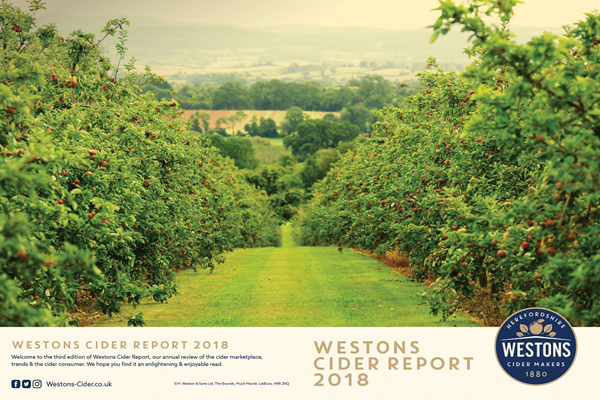Westons publishes third annual cider report

Westons Cider has launched its third annual Cider Report ahead of the 2018 summer cider season, revealing a series of new opportunities for drinks retailers across both the UK’s on and off trade.
The 32-page report highlights that almost half of households (45.5%) buy cider with sales up by +3.5% in value to £2.98bn. The report also provides a forensic analysis of the category to uncover a number of essential trends.
Fruit cider ‘here to stay’
Reinforcing Westons’ recent launch of Stowford Press Mixed Berries into the UK on-trade, and the introduction of Rosie’s Pig Raspberry Roller to the off-trade, latest data from CGA Strategy shows that fruit cider continues to bring more consumers into the cider category, including women, who make up 60% of fruit cider drinkers compared with 47% of all cider drinkers.
At the same time, fruit cider is also bringing younger consumers into the category, with half of fruit cider drinkers aged 18-34 compared with 36% of all cider drinkers.
Matthew Langley, insight and innovation manager at Westons Cider, says, “Fruit cider has grown by 338% in the last 12 years to represent 27% of the overall category across the on and off trade in 2017, so we are predicting that it will account for almost half of all cider sales by 2023 if current growth continues at the same rate.”
The health agenda
Westons also highlights an opportunity for both on and off trade retailers to tap into a growing trend for health and wellness, with Stowford Press Low Alcohol cider alone now worth £411,027 per annum in the UK off-trade – and growing by year on year.
“Low and no alcohol products are rising in credibility and acceptance,” explains Langley, “and are now seen by consumers as a positive discovery choice based on taste, flavour and experience rather than just having to choose something when ‘you’re not drinking’.
“The implications and opportunities for the cider category are huge, and cider producers that can focus on quality, heritage, provenance and craftsmanship to harness this trend are in a strong position.”
The decline of white cider and pear cider
In stark contrast with the continued success of traditional, crafted ciders – which are growing at +22% in the off trade alone – value white cider and pear cider are predicted to continue their respective declines in popularity.
“In the last year, sales of value white cider have fallen by -2.6% in both value and volume across all channels and there are no signs of that trend changing,” explains Langley.
Meanwhile, pear cider has fared even worse, with on trade volumes down by -22.6% to account for just 2% of all cider sales, and off-trade sales down by -4.2% (value) to account for 8% of all cider sales in that channel.
“Despite these steep declines across both the on and off trade, pear cider continues to enjoy significant and widespread distribution, suggesting that some operators and retailers have not yet caught up with the consumer, who moved on from pear cider some time ago,” adds Langley.
On trade hotspots, challenges and opportunities
Whilst wine, RTDs, beer, soft drinks and spirits volumes have all declined, cider has enjoyed strong volume growth, with total sales of cider and perry now worth £1.86 billion and value growing ahead of volume (up +2.4% and +0.3% respectively).
However, despite this success and strong value and volume growth across many UK regions, challenges remain, with a strong performance from draught cider (volumes up +3% to account for 71% of all on trade cider sales) offset by a challenging year for packaged ciders (volumes down -3%).
“With 51% of on-trade cider drinkers saying they actually prefer packaged cider, there is a clear opportunity for many operators to build sales of packaged cider, so we are providing clear stocking recommendations in this year’s report, including a simple to follow ‘right brand right outlet’ analysis for operators looking to make the most out of their packaged cider offer,” explains Langley.
“We would also particularly urge London operators to take a look at our stocking guides for both draught and packaged cider, as the capital city is the only region in our report not experiencing a growth in value sales of cider overall (down -3.3%), driven by a steep value decline in sales of pear cider (down – 39.8%) and packaged cider (down -7.6%), despite historically being a region that over-indexes on packaged cider.”
Off trade shoppers getting more adventurous, more sophisticated and ‘canny’
With off trade value sales of ‘crafted’ ciders up by +22% (led by single glass bottle brands such as the strong-growing Henry Westons), premiumisation and a more adventurous consumer are the strongest drivers in an off trade cider category that is now worth £1.12 billion and growing by +5.3% (value).
“Despite strong gains in all segments of the market apart from value white and pear cider, our report clearly shows that the biggest category growth lies in crafted cider,” explains Langley, “so retailers should really bear this in mind when making their stocking decisions.
“Fruit cider also continues to deliver a strong performance for off trade retailers, up by +11% in value to account for 33.5% of all sales, and one of the most interesting movements has been in packaging, with cans now accounting for 46% of all fruit cider sales.
“Indeed, canned fruit cider in this channel has seen year on year value growth of +31.8% whereas bottled fruit cider has declined, so retailers should also bear this in mind when deciding which brands and formats to stock.”
The demand for cans, adds Langley, is also being seen across the wider category, to account for 48% of all cider sales and up by +13.3% year on year, largely at the expense of larger plastic bottle offerings, sales of which are down by -11.3% to account for just 15% of all sales.
Meanwhile, it appears that off trade cider shoppers are also getting more sophisticated, with 67% of at home cider serves now occurring with food[1], whilst the average cider shopper is also marginally more wealthy than the average UK shopper, with 26% of cider shoppers earning more than £40,000 (compared with UK average of 22%).
Langley concludes, “Our report shows that there is a bright future for cider across both the UK on and off trade, but this will clearly be driven by crafted, premium and fruit offerings throughout 2018 and beyond. I would urge operators across both channels to use our report as a guide on how best to navigate this dynamic and sophisticated category, and to make good use of our impartial stocking guides.”



